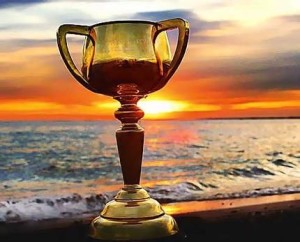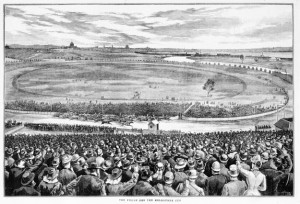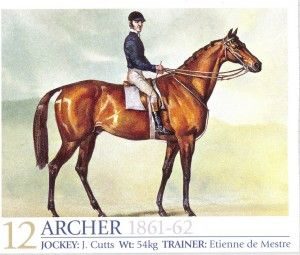IT’S THAT TIME AGAIN – THE MELBOURNE CUP
 Australian racing’s most prestigious horse racing prize – the Melbourne Cup. In more recent years, the Cup does a tour of the country in the lead-up to the running of the great race, allowing those who might not otherwise get a chance to ever get to Melbourne to witness a running of the Cup to still feel a part of it.
Australian racing’s most prestigious horse racing prize – the Melbourne Cup. In more recent years, the Cup does a tour of the country in the lead-up to the running of the great race, allowing those who might not otherwise get a chance to ever get to Melbourne to witness a running of the Cup to still feel a part of it.
The excitement of the Spring Racing Carnival in Melbourne, Victoria has well and truly swung into action. This world class event with the Carnival showcasing thoroughbred racing, fashion and entertainment is one of the finest in the world. The highlight of the Carnival is the Melbourne Cup, held every year on the first Tuesday in November.
Racecourse Architecture: Fantastic Flemington – Finish of the 1885 Melbourne Cup at Flemington illustration. Photo via State Library of Victoria.
Known as ‘the race that stops a nation’, the Melbourne Cup Day is a public holiday in Victoria and no matter where you live or work in Australia, most people stop what they’re doing to listen to the cup. All over Australia the possibility of winning, (a slim one I might add)a love of horse racing and fun can be enjoyed with office sweeps and dressing up to celebrate.
- The Melbourne Cup is now the richest 3200 metre handicap race in the world. It went metric in 1972.
The first running of the Melbourne Cup was in 1861, and I can’t help but wonder how the race club committee would view the Melbourne Cup of today.
- The winner of the 1863 race, Banker, has the distinction of carrying the lightest weight to victory (5 stone, 4 pounds / 34 kg). Carbine is the record holder for the highest weighted winner (10 stone, 5 pounds / 66 kg).
Could they have envisaged the Cup lasting a century and a half and growing to become a significant part of our social and sporting culture. For me personally, horses and fashion are two of my passions, add a book into the equation and I would be in heaven!
- The most memorable winning streak is the three consecutive cups won by Makybe Diva (2003-05). Other significant winners include Archer (1861-62), Carbine (1890), Phar Lap (1930), Rain Lover (1968-69) and Might and Power (1997).
A SHORT HISTORY ON HORSE RACING
ARCHER (Aus) B c 1856, William Tell (GB) – Maid of the Oaks, by Vagabond. Trained by Etienne de Mestre, ridden by John Cutts, won first two runnings of the Melbourne Cup in 1861 and 1862. Denied a start in 1863 on technicality. Legend had it he walked from de Mestre’s Nowra, NSW stables to Melbourne, now disproved. Winner also of 1861 Australian Plate, Randwick Plate, 1862 AJC All-Aged Stakes etc. Not a stud success, he died 22 December 1872 after eating green barley, aged 16.
The competitive racing of horses is one of human kinds most ancient sports, having it’s origins among prehistoric nomadic tribesmen of Central Asia who first domesticated the horse in about 4500 BC. For thousands of years horse racing flourished as the sport of kings and the nobility.
By the time humans began to keep written records, horse racing was an organised sport in all major civilizations from Central Asia to the Mediterranean. Both chariot and mounted horse racing were events in the ancient Greek Olympics by 638 BC, and the sport became a public obsession in the Roman Empire.
The origins of modern racing lie in the 12th century, when English knights returned from the Crusades with swift Arab horses. Over the next 400 years, an increasing number of Arabian stallions were imported to breed to English mares. This cross produced horses that combined speed and endurance. Matching the fastest of these animals in two-horse races for a private wager became a popular diversion of the nobility.
Horse racing began to become a professional sport during the reign (1702-14) of Queen Anne, when match racing gave way to races involving several horses on which spectators wagered. Racecourses sprang up all over England , offering increasingly large purses to attract the best horses. These purses in turn made owning and breeding horses for racing profitable. With the rapid expansion of the sport came the need for central governing authority. In 1750 racing’s elite met at Newmarket to form the Jockey Club, which to this day exercises complete control over English racing.
In Australia Thoroughbred horse racing is an important spectator sport in Australia, and gambling on horse races is a popular pastime with A$14.3 billion wagered in 2009/10 with bookmakers and the Totalizator Agency Board (TAB). The two forms of Thoroughbred horse racing in Australia are flat racing, and races over fences or hurdles in Victoria and South Australia. Thoroughbred racing is the third most attended spectator sport in Australia, behind Australian rules football and rugby league, with almost two million admissions to 360 registered racecourses throughout Australia in 2009/10. Horse racing commenced soon after European settlement, and is now well-appointed with automatic Totalizator, starting gates and photo finish cameras on nearly all Australian racecourses.
On an international scale Australia has more racecourses than any other nation. It is second to the United States in the number of horses starting in races each year. Australia is third, after the U.S. and Japan for the amount of prize money distributed annually.
Information from www.wikipedia.org
Several of the above facts are from Katie Flack’s Blog, Melbourne Cup Facts
http://blogs.slv.vic.gov.au/such-was-life/sport-such-was-life/melbourne-cup-facts/


Leave a Reply